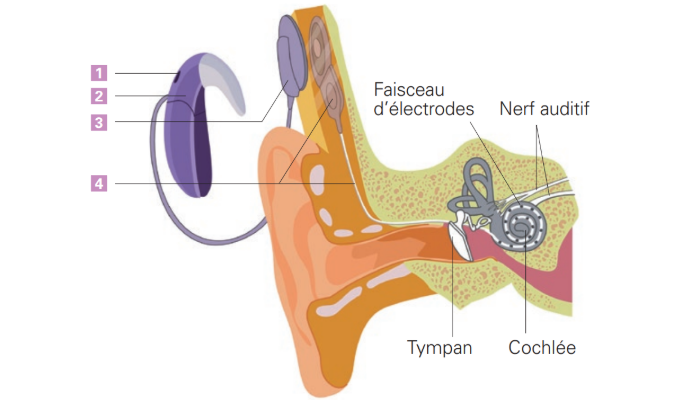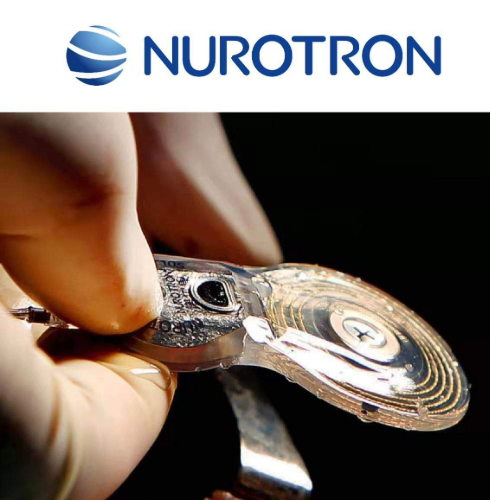Cochlear Implant
What Is A Cochlear Implant?
A cochlear implant is an electronic device that allows people with severe hearing loss to have better access to sounds. It is composed of an internal part and an external part.
The internal part is inserted under the skin behind the ear during surgery that requires general anesthesia.
The external part consists of the processor which is connected to the antenna. The antenna is equipped with a magnet which allows it to be held in place with respect to the internal part so that contact can be established.
The internal part and the external part are essential for the functioning of the implant.
How Does It Work ?
- The microphone picks up sounds from the environment. Then the sounds are analyzed by the processor.
- The coded sounds are transmitted to the internal part, which transforms them into electrical impulses.
- Electrical impulses are directed to the electrodes.
- The electrodes stimulate the auditory nerve which sends information to the brain.

Indications for use
Cochlear implants are indicated for severe to profound bilateral sensorineural hearing loss. Implantation is most often unilateral, but bilateral implantation may be indicated:
- In children – Age of implantation: CIn prelingually deaf people, implantation should be as early as possible. Early implantation gives better and faster results on language comprehension and production than late implantation. Beyond 5 years, in cases of profound or total congenital deafness that is not progressive, there is no indication (except in special cases) unless the child has developed an appetite for oral communication. If the child has entered into oral communication, he or she can benefit from implantation regardless of age. Young congenitally deaf adults can be implanted.
- In adults – Age of implantation: There is no upper age limit for cochlear implantation in adults.
- In the elderly: the indication is made after a psychocognitive assessment. There is generally no indication for primary implantation in adults with prelingual deafness.

What Results Are Obtained With The Implant?
Results vary greatly from person to person, and the implant will never restore normal hearing. It is impossible to predict how you will hear. We can program your implant to be optimal, but we have no control over the functioning of your auditory nerve, central auditory pathways, or auditory cortex, all of which play a large part in the quality of sound you will hear.
Typically, when we determine that a person with hearing loss is a candidate for a cochlear implant, it is because the chances are good that they will hear better with the implant.
The cues provided by the cochlear implant complement the visual information of lip reading, which helps improve communication. With the implant, all recipients can hear sounds and distinguish between short and long, loud and soft sounds.
Most of them can also distinguish between high-pitched and low-pitched sounds and recognize some sounds from everyday life, such as a doorbell, a car horn, or a telephone ringing. Most of them can also recognize a word or phrase from a limited selection of words or phrases.
It is impossible to predict how a person will perceive speech after receiving a cochlear implant. The vast majority of patients can hear speech, but it usually takes time before they begin to understand sounds (especially children). With an effective follow-up program, a period of rehabilitation, and full-time use of the processor, speech understanding can be gradually acquired. If you wear a conventional hearing aid in your other ear, we may recommend that you stop wearing it for a period of time until you have adjusted to your implant.
Some people can understand words or sentences without the aid of lipreading and can use the telephone for simple conversations with people they know well.
Finally, some people can understand almost everything without the aid of lipreading, but this is rarer.
Listening to music is rarely enjoyable with a cochlear implant. Indeed, the implant was designed to promote speech perception, and the sound-coding strategies focus on speech. Some people, however, report a certain pleasure in listening to music.


What Implant Does AUDECIBEL Offer You?
Audecibel has partnered with « Nurotron Biotechnology » company, a world leader in the supply of medical materials. With a specialty in the development and design of cochlear implants and hearing aids.
Our choice is CS-10A cochlear implant, CS-10A ultra-thin high-strength titanium implant not only follows the mature international advanced technology, but also has the largest number of channels in the world. Its electrodes have moderate hardness, with the unique advantage of easy insertion, and the surgical opening and bone crushing volume have met the requirements of minimally invasive surgery.
- High efficiency, being the world leader, with the largest number of electrodes in the world (24+2), effectively increasing the resolution of sounds, and providing the perfect sound details.
- Soft electrodes to reduce trauma to the cochlear structure, which may save residual hearing.
- The unique electrode design, to ensure that the electrode contacts face the modiolus.
- The electrodes can withstand a stretch tensor of 15 mm without fracture.
- Small bone crushing volume, for fast and safe surgery.
- Materials with reliable and durable biocompatibility.
- High strength titanium shell, safe and reliable, well sealed.
- Thin shell, thin and beautiful, and unique design radian, so that the lifting of the implanted part is not obvious, applicable to both adults and children.
- Independent self-development safe and reliable decoding chips, providing multiple safety protection functions.
